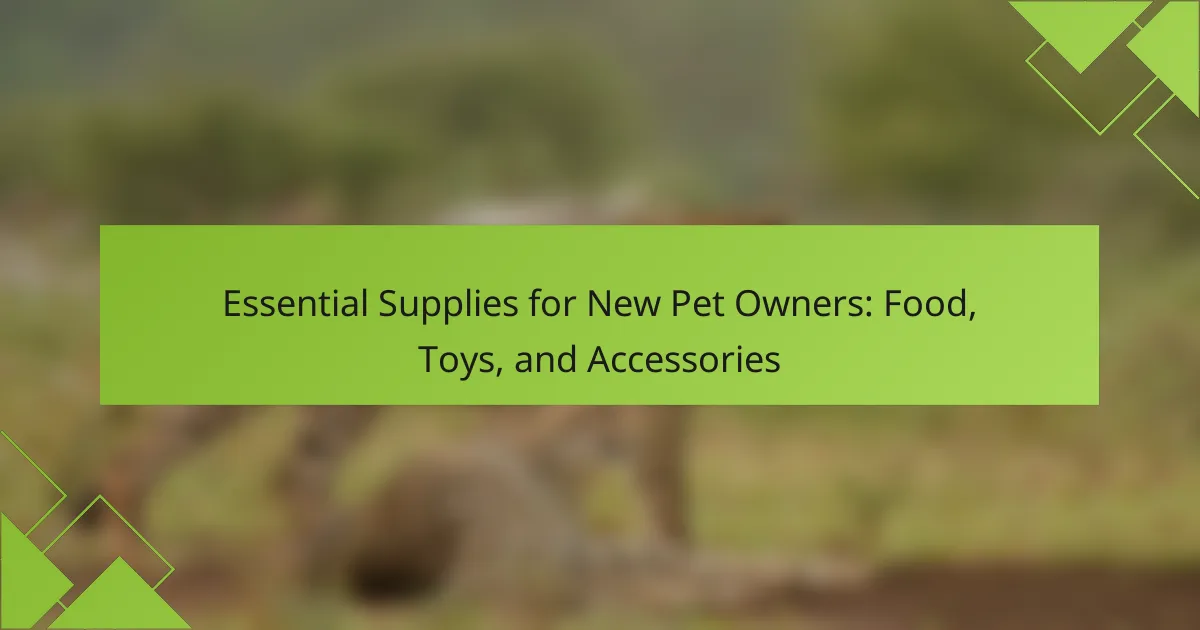New pet owners face the challenge of ensuring their pets are healthy and happy. Essential supplies include high-quality food and fresh water for nutrition, interactive toys for mental engagement, and necessary accessories for comfort and safety. Understanding product safety and avoiding common mistakes is crucial for creating a nurturing environment. By prioritising quality and suitability, pet owners can enhance their pets’ well-being effectively.

What essential food supplies do new pet owners need?
New pet owners need essential food supplies to ensure their pets are healthy and happy. Key items include high-quality pet food, fresh water, food and water bowls, and treats.
1. High-quality pet food: Choose age-appropriate formulas for optimal nutrition.
2. Fresh water: Provide clean water daily to keep pets hydrated.
3. Food and water bowls: Select durable, easy-to-clean options.
4. Treats: Use as rewards for training and bonding.
These supplies form the foundation for a pet’s well-being and help establish a routine.
Which types of pet food are best for different animals?
Different animals require specific types of pet food tailored to their nutritional needs. Dogs benefit from high-protein kibble, while cats thrive on wet food rich in animal proteins. Small mammals like rabbits need hay-based diets, and fish require specialised flakes or pellets. Birds often do best with seed mixes or pellets designed for their species. Reptiles may need live food or specialised diets depending on their type.
How to choose the right food based on pet age and health?
Choose pet food based on age and health needs. Puppies require high-protein diets for growth, while senior pets benefit from lower-calorie options to maintain a healthy weight.
Consider specific health conditions. For instance, pets with allergies may need grain-free food, while those with dental issues might require softer textures. Always consult a veterinarian for tailored recommendations.
Monitor your pet’s response to food. Changes in energy, coat condition, or digestion can indicate whether the food meets their needs. Adjust as necessary to ensure optimal health.
Regularly review food labels for nutritional content. Look for high-quality ingredients and avoid fillers. This ensures your pet receives the best nutrition based on their unique requirements.
What are the benefits of high-quality pet food?
High-quality pet food provides numerous benefits, including improved health, better digestion, and increased energy levels. It often contains higher nutritional value, which supports a pet’s immune system and overall well-being. Quality ingredients reduce the risk of allergies and promote a shiny coat. Additionally, it can lead to a longer lifespan for pets. Investing in high-quality food is essential for pet owners who prioritise their pets’ health.
How to transition pets to new food effectively?
To transition pets to new food effectively, introduce the new food gradually over a week. Start by mixing a small amount of the new food with the old food, gradually increasing the new food’s proportion. Monitor your pet’s response and adjust as needed. This method minimises digestive upset and allows pets to acclimate to the new flavour and texture.

What toys should new pet owners consider for their pets?
New pet owners should consider interactive toys, chew toys, and puzzle toys for their pets. Interactive toys stimulate mental engagement and promote physical activity. Chew toys support dental health and satisfy natural chewing instincts. Puzzle toys challenge pets and enhance problem-solving skills.
Which types of toys are suitable for different pet sizes and breeds?
Different pet sizes and breeds require specific toy types to ensure safety and enjoyment. Small pets, like Chihuahuas, benefit from soft plush toys, while medium breeds, such as Beagles, prefer durable rubber toys. Large breeds, like Labradors, need sturdy chew toys designed for strength. For puppies, interactive toys stimulate play, while senior pets may enjoy gentler options. Always consider the pet’s chewing habits and activity level when selecting toys.
How do toys contribute to a pet’s mental and physical health?
Toys significantly enhance a pet’s mental and physical health by providing stimulation and promoting exercise. Engaging with toys reduces boredom, alleviates anxiety, and encourages healthy play behaviours. Interactive toys, such as puzzle feeders, stimulate cognitive functions, while chew toys support dental health. Regular playtime with toys fosters a stronger bond between pets and their owners, contributing to overall well-being.
What safety features should toys have for pets?
Toys for pets should have non-toxic materials, durable construction, and safety features to prevent choking hazards. Look for toys designed specifically for the size and chewing strength of your pet. Ensure toys are free from small parts and sharp edges. Regularly inspect toys for wear and tear to maintain safety.

What accessories are necessary for new pet owners?
New pet owners need essential supplies to ensure their pet’s well-being. Key accessories include food and water bowls, a comfortable bed, toys for mental stimulation, a collar with an ID tag, and grooming tools. These items create a safe and engaging environment for the pet.
Which grooming tools are essential for pet care?
Essential grooming tools for pet care include brushes, combs, nail clippers, and grooming scissors. These tools maintain your pet’s hygiene and coat health. Regular brushing prevents matting and reduces shedding. Nail clippers ensure safe nail maintenance, while grooming scissors help shape fur and remove tangles. Investing in quality tools enhances your pet’s overall well-being.
How to select the right bedding and housing for pets?
Selecting the right bedding and housing for pets involves considering their comfort, safety, and specific needs. Choose bedding that is easy to clean, hypoallergenic, and suitable for the pet’s size. For housing, ensure it provides adequate space, ventilation, and protection from the elements. Consider the pet’s behaviour; for example, cats may prefer enclosed spaces while dogs may need open areas.
What are the must-have training supplies for new pet owners?
New pet owners should prioritise essential supplies like food, toys, and accessories. Key items include high-quality pet food tailored to the animal’s age and size, durable toys for mental stimulation, and basic accessories like collars, leashes, and bedding.
1. Pet Food: Choose age-appropriate, nutritious options.
2. Toys: Select a variety for physical and mental engagement.
3. Collars and Leashes: Ensure proper fit and safety.
4. Bedding: Provide a comfortable resting area.
5. Grooming Supplies: Include brushes and nail clippers.
6. Training Aids: Use clickers or treat dispensers for effective training.
These supplies will support the pet’s health, well-being, and training needs.

How can new pet owners ensure they are choosing safe products?
New pet owners can ensure they are choosing safe products by researching brands, reading labels, and checking for certifications. Look for non-toxic materials and ingredients. Prioritise products that have been tested for safety and are recommended by veterinarians. Additionally, consider the specific needs of your pet, such as size and breed, to avoid unsuitable items.
What certifications should pet supplies have?
Pet supplies should have certifications that ensure safety and quality standards. Look for certifications like the American Kennel Club (AKC) seal, Association of American Feed Control Officials (AAFCO) approval, and ISO certifications. These indicate adherence to health regulations and product testing. Additionally, organic certifications for pet food can signify high-quality ingredients.
How to read labels on pet food and accessories?
To read labels on pet food and accessories, focus on key information such as ingredients, nutritional value, and feeding guidelines. Check for high-quality protein sources and avoid fillers. Look for AAFCO statements to ensure balanced nutrition. Pay attention to serving sizes and expiration dates to maintain pet health.

What are common mistakes new pet owners make when buying supplies?
New pet owners often make mistakes such as buying the wrong food, neglecting proper toys, and overlooking essential accessories. Choosing food without considering the pet’s age and dietary needs can lead to health issues. Additionally, selecting toys that are not safe or suitable for the pet’s size can result in accidents. Failing to purchase necessary accessories like leashes, litter boxes, or grooming tools can hinder a pet’s well-being. Understanding these common pitfalls helps ensure a happy and healthy environment for pets.
How to avoid overbuying pet supplies?
To avoid overbuying pet supplies, plan purchases based on your pet’s specific needs. Assess essential items like food, toys, and accessories before shopping.
1. Create a checklist of necessary supplies based on your pet’s age, size, and activity level.
2. Set a budget for each category to prevent impulse buying.
3. Buy in bulk only for non-perishable items, ensuring you use them before expiration.
4. Regularly assess your pet’s preferences and needs to adjust future purchases accordingly.
Tracking usage and preferences helps you maintain a balanced inventory without excess.
What are the consequences of choosing low-quality products?
Choosing low-quality products can lead to negative consequences for new pet owners. These products may harm pets’ health, cause injuries, or lead to dissatisfaction.
Low-quality pet food often lacks essential nutrients, resulting in poor health outcomes. For example, inadequate nutrition can lead to obesity or malnutrition.
Toys made from substandard materials can break easily, posing choking hazards. Accessories that do not meet safety standards may cause injuries or discomfort.
Investing in high-quality supplies ensures better health, safety, and satisfaction for pets and owners alike.

What expert tips can help new pet owners optimise their purchases?
New pet owners can optimise their purchases by focusing on quality and suitability. Prioritise high-nutrition pet food tailored to your pet’s age and breed. Choose durable toys that promote engagement and safety. Invest in essential accessories like a comfortable bed and proper grooming tools to enhance your pet’s well-being. Consider eco-friendly options for sustainability. Research brands for customer reviews and ingredient transparency to ensure the best choices.
How to create a budget for pet supplies?
To create a budget for pet supplies, assess key categories and set limits. Start by estimating costs for essential items like food, toys, and accessories.
1. Determine monthly food costs based on your pet’s size and dietary needs.
2. Allocate funds for toys and enrichment activities to support mental stimulation.
3. Include grooming supplies and accessories like collars and leashes.
4. Factor in unexpected expenses such as veterinary care or replacement items.
Review and adjust your budget regularly to ensure it meets your pet’s evolving needs.
What are some recommended brands for pet food and accessories?
Recommended brands for pet food and accessories include Royal Canin, Hill’s Science Diet, Blue Buffalo, Purina Pro Plan, Kong, and PetFusion. These brands offer high-quality nutrition and durable products. Royal Canin is known for breed-specific formulas, while Blue Buffalo emphasises natural ingredients. Hill’s Science Diet focuses on veterinary-approved nutrition. Kong is recognised for its interactive toys, and PetFusion specialises in innovative pet accessories.
How to effectively research products before buying?
Research products before buying by focusing on quality, safety, and suitability for your pet. Start by reading reviews from trusted sources to gauge performance and reliability. Compare brands for ingredients in pet food, ensuring they meet your pet’s dietary needs. Evaluate the durability of toys and accessories, looking for materials that are safe and long-lasting. Check for warranties or return policies to protect your investment.
